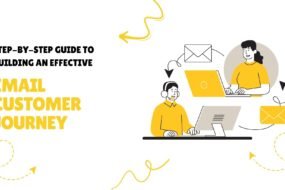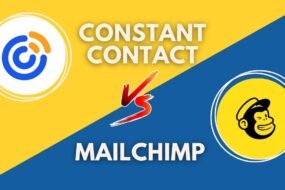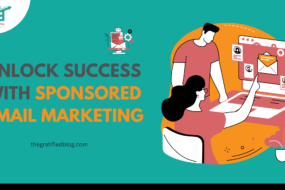
In the realm of ecommerce email marketing, numerous aspects emerge to think about. What is email marketing? Why do ecommerce businesses use email marketing? How do you email market? These are all valid inquiries, and we will answer them in this ultimate guide.
In this guide, we will discuss (10) ten e-commerce email marketing strategies you can start using today and the different types of e-commerce email and their purposes.
We’ll also answer some frequently asked questions about ecommerce email marketing so that you can make the most out of your campaigns.
So, let’s get started by defining it.
What Is Ecommerce Email Marketing?
It’s a way for ecommerce businesses to connect with their customers and potential customers through e-mail. It can build brand awareness, promote new products or services, generate sales, and more.
It ultimately comes down to knowing your target audience and segmenting your email lists effectively. With the right ecommerce email marketing strategy, you may establish a broad consumer base and strong partnerships.
Why Do Ecommerce Businesses Use Email Marketing?
There are many reasons why ecommerce businesses use email marketing; 3 Most Important reasons are as follows:
- It is an effective method for engaging and fostering connections with customers. Whether you’re looking to inform them about new products, build brand awareness, or promote sales and discounts, it can help achieve your goals by enabling real-time communication.
- Email marketing is highly customizable and allows you to personalize content based on customer preferences. You can segment email lists based on interests, behavior, purchase history, demographics, and more – which helps ensure that your email messages reach the appropriate individuals at the right time.
- With email marketing tools like EngageBay, Mailchimp, and Sendpulse, you can capture the email addresses of potential customers interested in your business or products. This helps to grow your email list and increase the overall ROI of your email campaigns.
Overall, email marketing strategy for ecommerce is a successful communication approach for companies. Let’s now discuss the techniques you might employ to promote your business via email.
Five Ecommerce Email Marketing Strategies
Source: Youtube.com
There are many different ecommerce email marketing best practices that you can use, but here are Five of the most effective ones:
- Create email content that is targeted, relevant, and valuable to your customers. This can include product announcements, informational email newsletters, case studies, and more.
- Use ecommerce email marketing automation tools to streamline email marketing processes and ensure email campaigns are sent out on time. Automation software can also help you personalize email messages based on customer preferences and reduce the risk of spam complaints.
- Incorporate ecommerce email marketing campaigns, such as creating email subject lines that are concise and engaging, using responsive email templates for mobile devices, and using plain text instead of HTML email format.
- Test email content to determine what works best for your audience – for example, testing the timing and frequency of email campaigns or testing different email subject lines to see which ones result in more opens and clicks.
- If you’re wondering, “Why are my emails going to spam?” it’s crucial to monitor your campaign metrics and adjust your strategy based on performance data. Consider critical indicators such as open email rates, click-through rates, conversion rates, unsubscribe rates, spam complaints, social shares, etc.
As you can see, there are many email marketing strategies that you can use when email marketing for e-commerce. Let’s find out the e-commerce email types that you can use.
Eight Types Of E-commerce Email Templates
There are many different email templates that you can use for ecommerce email marketing, but here are Eight of the most popular ones:
Welcome Email
This email is used to welcome a new customer to your email list or to thank an existing customer for signing up. It can include details about your business or products, as well as information about how often email messages will be sent.
Source: stripo.email
Promotion Email
This email is used to promote your products or services to customers. It often includes a product image, details about the product, and any sales or promotions you may be running. It can also include a call to action, such as a link to buy or sign up for more information.
Source: optimonk.com
Re-Engagement Email
This email is designed to help you reconnect with inactive customers by re-engaging them with your email marketing efforts. This can include sending content that reminds them of your brand, highlighting recent news or happenings in your industry, or simply offering incentives for customers to make another purchase from you.
Source: sendlane.com
Cart Abandonment Email
Suppose a customer leaves items in their shopping cart on your website. In that case, this email can encourage them to complete their purchase by reminding them what interests them and providing a direct link to the cart with their items still inside.
Source: optimonk.com
Event Email
This email promotes live events or webinars you may host at your business, such as product launches, training sessions, and more. It often includes details about the event and any registration or RSVP information for interested customers.
Source: pipedrive.com
Order Confirmation Email
This email is used to confirm a customer’s order online, typically by confirming order details, shipping address, and payment method. It can also include links to related content or purchase follow-up emails if the customer desires.
Source: chamaileon.io
Shipping Email
If your business offers products purchased online, send email updates to customers when their order has shipped. This email typically includes the tracking number for their shipment, as well as details about any estimated delivery date or information on how they can contact customer service with questions or concerns.
Source: emaildesign.beefree.io
Feedback Email
This email gathers customer feedback based on their recent purchase experience with your business. It can include a survey link, a form where customers can provide feedback themselves, or simply a call-to-action asking them to share their thoughts in some way.
Whether positive or negative, this feedback will help you better understand what your customers want and need from your efforts.
So, here are eight email templates you can use when email marketing for ecommerce.
Source: mailerlite.com
15 Ecommerce Email Marketing Mistakes To Avoid
Source: Youtube.com
Email marketing is a powerful tool for ecommerce businesses to engage with customers and drive sales. However, there are common mistakes that can hinder the effectiveness of your email campaigns. Here are 15 ecommerce email marketing mistakes to avoid:
- Neglecting personalization: Neglecting personalization in your email communications is a missed opportunity and a significant oversight that can prevent you from establishing meaningful connections with your customers. By overlooking the power of personalization, you essentially deprive yourself of the chance to forge a deeper bond with your audience.
- Overwhelming subscribers with too many emails: Overwhelming subscribers with excessive emails can harm your marketing efforts. When inundated with a constant stream of messages, subscribers may experience email fatigue, causing them to become disengaged or even unsubscribe from your mailing list.
- Ignoring mobile optimization: Ignoring mobile optimization can harm the success of your email campaigns. In today’s digital landscape, where most emails are opened on mobile devices, it is imperative to prioritize mobile-friendly design. You need to pay attention to this aspect to avoid alienating a significant portion of your target audience and missing out on valuable engagement opportunities.
- Poor subject lines: Poor subject lines can significantly impact the effectiveness of your emails. It’s crucial to recognize that subject lines serve as the initial gateway to your email content, making them the first impression recipients have of your message. To ensure optimal engagement, it is imperative to avoid vague or spammy subject lines that fail to convey the true essence of your email. Crafting a compelling follow-up email subject line is equally important, as it entices recipients to open your message and continue the conversation.
- Lack of segmentation: Lack of segmentation in your email marketing strategy can significantly hinder its effectiveness. When you send the same email to your entire subscriber list without considering their individual preferences and behaviors, you take advantage of the opportunity to establish a deeper connection with your audience.
- Neglecting A/B testing: Neglecting A/B testing is a grave mistake that can significantly hamper your ability to optimize and enhance the performance of your email campaigns. A/B testing, a powerful technique, empowers you to compare and analyze various elements within your emails, such as subject lines, calls to action (CTAs), or email designs.
- Sending irrelevant content: Sending irrelevant content to your subscribers can harm your engagement rates and overall email marketing success. When you send generic content that fails to resonate with your audience, they will likely quickly lose interest and disengage from your emails. To combat this, it’s essential to tailor your email communications to provide genuine value to your subscribers.
- Failing to optimize for deliverability: Failing to optimize for deliverability can harm your email campaigns. It is crucial to address this issue proactively to ensure your messages reach the intended recipients’ inboxes. To improve deliverability, staying up-to-date with the latest email authentication protocols and implementing them effectively is essential.
- Neglecting email list hygiene: Neglecting email list hygiene can harm your email marketing efforts. Maintaining a clean and engaged email list is not just important; it is essential for ensuring the effectiveness of your campaigns. By regularly implementing practices to remove inactive or bounced email addresses, you can optimize the quality of your subscriber base and enhance your overall email deliverability rates.
- Ignoring the power of automation: Ignoring the power in your email marketing strategy would be a missed opportunity to optimize your customer communication. By implementing automation, you can send timely and highly relevant emails triggered by specific actions or events, such as abandoned carts, post-purchase follow-ups, or personalized recommendations.
- Neglecting social sharing options: Neglecting social sharing options within your emails is a missed opportunity to maximize your reach and tap into the immense potential of social media for ecommerce. By incorporating social sharing buttons in your email campaigns, you can effectively extend your content’s visibility and encourage subscribers to actively engage with your brand by sharing it within their networks.
- Poor email design: Poor email design can have a detrimental impact on your email marketing efforts. A cluttered or unappealing email design fails to captivate recipients and discourages them from engaging with your content. To overcome this hurdle, investing in professional email templates that are visually appealing, on-brand, and thoughtfully structured with a clear hierarchy of information is essential.
- Failing to optimize for conversions: Failing to optimize for conversions can be a critical mistake in email marketing. To maximize the effectiveness of your email campaigns, it is crucial to include a clear call-to-action (CTA) that effectively guides recipients toward the desired action. A well-crafted CTA can be a powerful tool to drive engagement and encourage subscribers to take the desired actions, such as visiting your website or navigating to specific landing pages.
- Neglecting email analytics: Neglecting email analytics can be costly for businesses. It is essential to recognize the significance of analyzing email metrics as it provides invaluable insights into the success of your email campaigns. You gain a comprehensive understanding of your email performance by diligently tracking key metrics such as open rates, click-through rates, conversion rates, and return on investment (ROI). You can make data-driven decisions to enhance your overall email strategy.
- Lack of engagement and interactivity: Lack of engagement and interactivity can be a significant drawback regarding email marketing. Simply sending out passive emails that don’t encourage interaction may fail to captivate your subscribers and leave them disengaged. However, there are several effective strategies that you can employ to enhance engagement and create memorable experiences for your audience.
By avoiding these common ecommerce email marketing mistakes, you can enhance the effectiveness of your campaigns, improve customer engagement, and drive higher conversions for your business.
FAQs
1. How Much Should I Make From Email Marketing For E-Commerce?
There is no single answer to this question, as email marketing strategies and budgets will vary depending on your business and products or services.
However, email marketing is generally considered one of the most cost-effective digital marketing strategies, and you can typically expect a positive ROI if you use email marketing effectively.
2. How Often Should I Email My E-Commerce Subscribers?
Ans: This depends on your email marketing, business, and audience. Some businesses may email customers once or twice weekly, while others may email daily or multiple times.
Ultimately, it would be best to experiment with different email frequency and engagement metrics to find what works best for your business and customers.
Final Thoughts
Now that you know more about the importance of email marketing for ecommerce, it’s time to start your email marketing campaigns.
It can help you connect with your audience and achieve your business goals. So why wait? Get started today and start reaping the benefits of email marketing for your ecommerce business!
If you have questions about ecommerce email marketing, please comment in the comment section. We will be happy to answer you.
Thanks for reading 🙂








No Comments